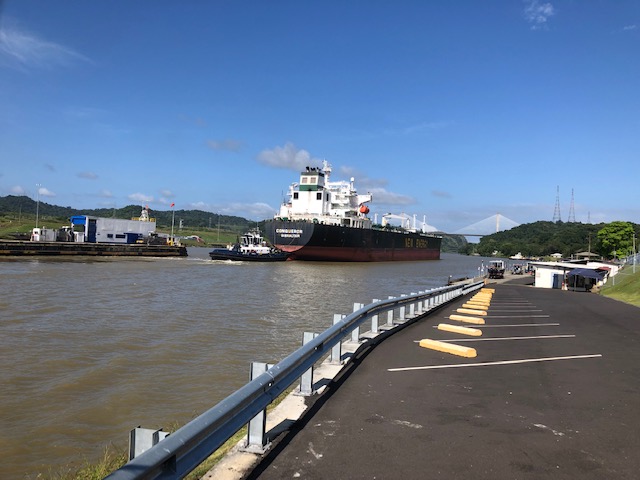
Ever since my own visit to Panama, I’ve considered it one of the “essential countries” for travelers.
And not just because it harbors a canal vital for global commerce. Panama also connects two continents (North and South America) and is a key link in a chain of countries (including neighboring Costa Rica and Colombia) that claims some of the greatest biodiversity on the planet.
For older baby boomers, it’s also an enticing location for retirement, offering comparatively low prices and modern amenities.
Contributing writer Robert Waite recently visited Panama and returned with this informative report:
By Robert Waite
Panama City – When I think of airlines and stopover programs, Icelandair comes immediately to mind.
For no extra charge, they allowed you to stop over in Reykjavik when flying from North America to Europe. They often threw in discounted hotel stays and a trip to the hot spring-fed Blue Lagoon.
But I recently discovered an equally tantalizing stopover: Panama.
We were planning a trip to Ecuador and the best airline connections were on Copa Airlines through Panama City.
That’s when I noticed the stopover offer.
My partner and I had never been to Panama. And we had the luxury of a few days on our return flight from Quito.
At a minimum, we had an interest in seeing the canal. For me, that interest stretched back to the 1970s, when I was working on Capitol Hill during the time of the Panama Canal debates.
The only other thing I knew about the country was that reams of documents held by a Panamanian law firm regarding off-shore banking accounts, dubbed “The Panama Papers,” were hacked and widely distributed in 2016 by the International Consortium of Investigative Journalists.
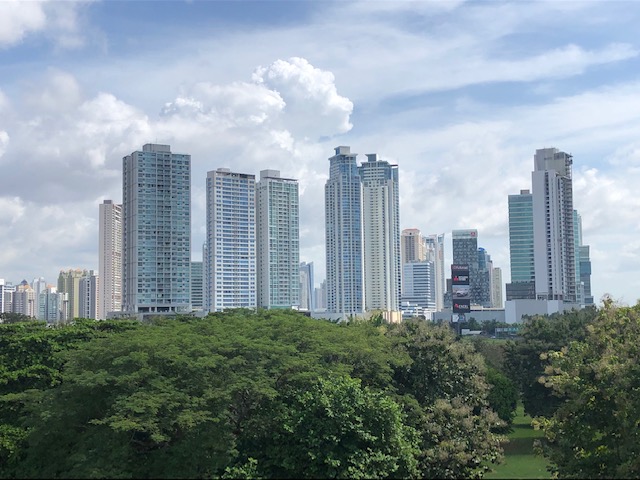
Mini-Dubai
Arriving in Panama City, you do get the feeling that somebody must have parked some money there.
The city is festooned with gleaming high-rise buildings, mostly occupied by financial institutions and law firms. From a distance it looks like a mini-Dubai.
But during our four-day stay, we found there is much to the country beyond banking – and that experiencing the canal is best done over several days, rather than from the deck of a cruise ship.
We were met by our guide, Richard Cahill, a Panamanian-American whose dad had worked for the Panama Canal Authority in the Canal Zone.
He suggested we start at the beginning – the ruins of Panama Viejo, the first city founded by Europeans on the Pacific coast of the Americas.
Panama Viejo became famous as a transfer point for Spanish galleons sailing up from Peru ladened with gold and silver. It featured a heavily defended repository for these riches – a Ft. Knox-by-the-sea.
The problem was that all of its cannons were aimed out to sea and an English pirate by the name of Henry Morgan – yes, the same Captain Morgan who now hosts party animals in rum commercials – came by land from the Caribbean side in 1671.

Surprise Party
Much as Hannibal surprised the Romans by traversing the Alps (and the Japanese would later surprise the British at Singapore), Morgan routed the Spaniards and seized the booty.
The retreating Spanish defenders torched the city, leaving the ruins you see today. Highlights here include the Old Panama Museum and the remnants of a cathedral, where you can climb to get a panoramic view.
A “newer” old city, Casco Viejo, is well worth exploring.
Much of it has been restored to its colonial glory and it is filled with heritage buildings, including the Presidential Palace and the Church of San Jose with its stunning Golden Altar. There are numerous shops and restaurants in the district.
But the highlight of any Panama City stopover is a visit to the Panama Canal and its surrounding nature reserves and attractions.
The best place to start is the Miraflores Visitor Center, located at the Miraflores Locks. There is a viewing platform where you can gaze down at the ships making the transit east or west, to the Caribbean or the Pacific.
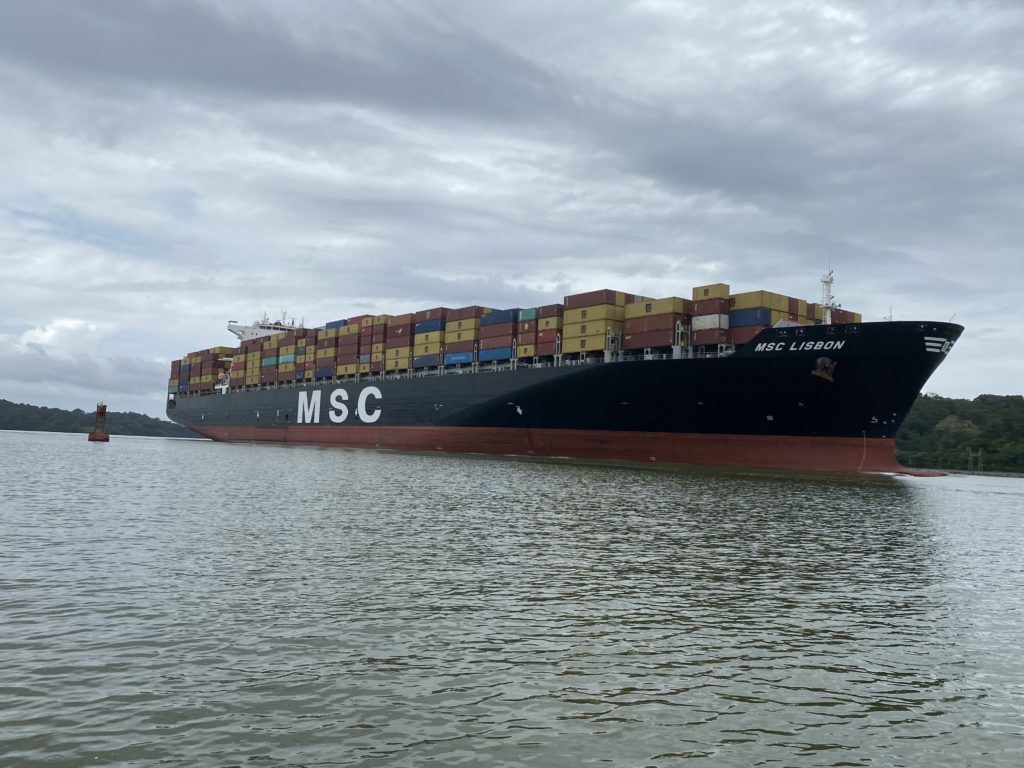
Political Intrigue
The Miraflores complex also a contains a multi-floor museum and an IMAX Theater.
Taken together, they provide an excellent narrative of the canal’s storied but often deadly history, including a failed 1880s French attempt that cost 20,000 lives.
They also detail the political machinations that subsequently resulted in Panama separating from Colombia to form its own nation in 1903, as well as America’s selection of Panama over Nicaragua as the preferred route connecting the Atlantic and Pacific.
The canal — which completed a sizeable expansion in 2016 to allow for megaships to make the passage — is an engineering marvel, while the former U.S. Canal Zone is an early example of a carefully planned community, meticulously laid out and well maintained to this day.
Panamanians are particularly proud of the fact that they have run the 50-mile (82 km) long waterway since 1999 without incident or interruption (vs. the rival Suez Canal, for example).
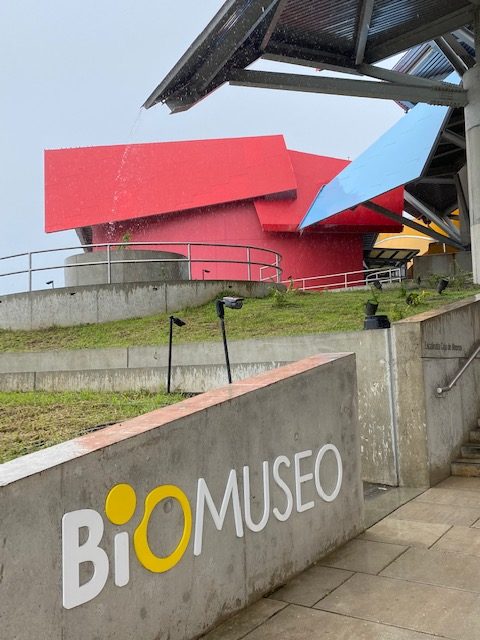
Natural Wonders
But the real wonders in and around the Zone are natural ones.
You would do well to visit Panama City’s Biomuseo (Biodiversity Museum). This architectural gem was designed by Frank Gehry to resemble the layers of the jungle canopy (which is especially evident during a tropical shower).
Inside you learn that Panama is relatively new geologically, yet remarkably diverse due to its geographic positioning between Colombia to the south and neighboring Central American nations to the north.
Armed with this knowledge, we next headed out on a small boat onto Gatun, a man-made lake that forms about two-fifths of the canal’s length. Much of the land around the lake is a nature preserve, teeming with wildlife, including several species of monkeys, tropical birds, and the occasional snake.
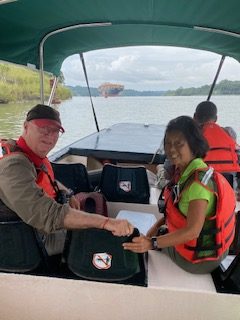
Monkey Business
Only locals are allowed to navigate the waters of the lake – and, in any event, only they and professional guides know the best places to get up close and personal with white-faced capuchins and other of our curious primate cousins.
You also find yourself quite close to the large ships plying the lake, including immense container vessels. The ships keep to a prescribed route marked with buoys and operate under orders not to stop – so it’s best not to tarry while crossing in front of them.
An equally rewarding experience is a walk along the Canal Zone’s Pipeline Road Trail through Soberania National Park. While the pipeline itself was never built, the walkway is an excellent opportunity to see additional species of birds, including Toucans, making this relatively easy trek especially popular with birders.
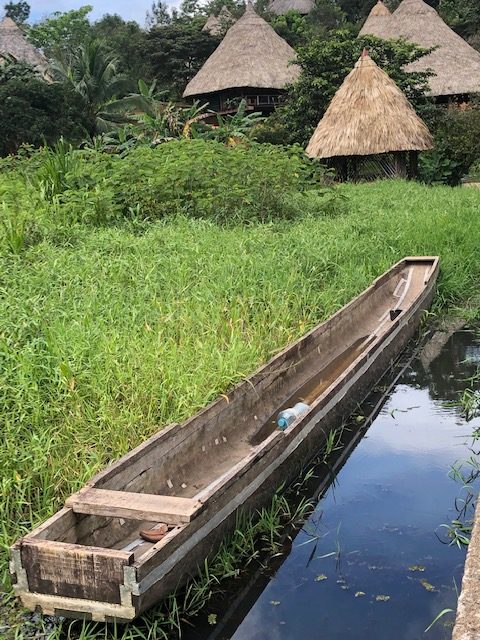
Cultural Preservation
A highlight of our time in Panama was a visit to the Embera indigenous village on the shores of the Gatun River. After driving 90 minutes out of Panama City you board a motorized piragua (dugout canoe) and travel upstream through lush forest to reach a community comprised of approximately 80 individuals.
Along the way you’ll likely see Amazon, Ringed, and Green Kingfishers; the Little Blue and Green Heron; and the Great Egret, to name a few species.
The Embera have relocated to this site from Panama’s remote Darien province. Situated on the Colombian border, it has been overrun by Haitian and Venezuelan refugees. Seeking to maintain their culture and identity, the Embera have moved further up the isthmus – and closer to curious tourists, with whom they share their traditions, including food and dance.
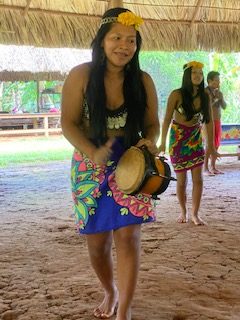
Just a Taste
Our overall impression at the end of the stopover experience is that we should have stopped over longer.
I mentioned this to a friend of our guide, Woodrow Oldfield, who heads up marketing for Visit Panama.
“That’s really the intent of the promotion. We give you a taste and you’ll want to come back, as you learn just how much more our country has to offer.”
Indeed, he told me that they are launching a new campaign called “Live For More,” aimed at what he calls “discerning tourists.” And who among us thinks we are anything less than discerning?
According to Oldfield, the campaign is about the abundance of riches that Panama offers. “Panama is at the intersection of nature, cultures, geographies, and passions,” he exudes. “It’s a place where different worlds converge: traditional and modern, cosmopolitan and rural, Caribbean and Pacific, biodiversity and commerce.”
In short, Panama is more than just a path between two seas or a place to stash your riches – and it is definitely worth a visit. We plan to return.
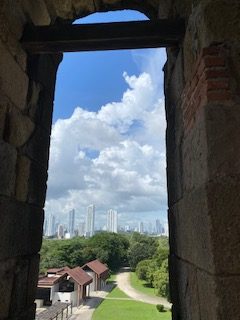
If You Go
The Copa stopover is valid for up to six nights and seven days. As always, check on public health advisories in advance. We travelled in mid-November, prior to the Omicron variant wave. Most venues were open, but the IMAX Theater at Miraflores was closed.
We stayed at the Bristol Hotel in the modern, business section of the city. A better choice might be one of the heritage hotels in Casco Viejo, the city’s UNESCO-listed historic quarter. Superior properties include Central Hotel Panama and La Concordia Boutique Hotel.
A good place for a cocktail is Casa Casco Mojitos, which has a rooftop bar. Primitivo Steakhouse & Club is an excellent choice for dinner.
Our land arrangements were made through Enchanting Travels, Greenwood Village, Colorado. Guide Richard Cahill can be reached at panamacahill@gmail.com
Useful information can be found at www.visitpanama.com
Top photo credit: Robert Waite
Author Bio:
Robert Waite has been writing about travel for 50 years. His articles have appeared in publications from the Boston Globe and San Francisco Examiner to the Toronto Star and Washington Post. Look for his upcoming posts on Ecuador and the Galapagos here at clarknorton.com.
Also by Robert Waite:
Get Your Thrills from the Sea on Route 133
And by Clark Norton:
Who was the real St. Patrick? Find out here.
Reader Comments:
As always, Robert Waite’s posting is wonderfully informative. Bravo from a fellow traveler! I’d like to add a reading recommendation. Anyone who shares Robert’s (and Clark’s) interest in the historical backdrop of a destination would do well to secure a copy of “The Path Between the Seas: The Creation of the Panama Canal, 1870–1914, David McCullough’s epic account of an engineering miracle that was only accomplished at the cost of a humanitarian nightmare. (Robert alludes to that cost, an estimate 20,000 lives, in his article.) — Frank Viviano fviviano@gmail.com
Clark’s reply:
Thanks, Frank, for your kind words about our highly talented contributing writer, Robert Waite, and your always excellent observations and suggestions. Yes, the David McCullough book is required reading for anyone going to Panama or who just wants to know more about this fascinating yet brutal piece of history.
Robert Waite’s reply: I want to join Clark in thanking Frank for mentioning “Path Between the Seas” – definitely a must-read for anyone going to Panama and/or passing through the canal. I did mention the book in an article I published on the politics of the Panama Canal Treaty, which can be found here:
Bob, Your trip sounds great. I could relate to your experience because several years ago I listened to the Path Between the Seas and was amazed by the dedication of first the French and then the US under Teddy Roosevelt to take it over to work towards completion. To think the canal might have gone through Nicaragua as that was an option at the time the French were under construction. — Bob Lowenthal bob.lowenthal68@gmail.com
Been waiting to go to Panama for a long time we’ve actually booked a trip two different times and had to cancel. Now I’m afraid to get on cruise ships because of Covid. Would be good if I could just fly into Panama stay at a hotel and have my my itinerary planned out for me to all the neat places. Really enjoyed your article look forward for more thank you. — CC Leight












4 Responses to Exploring Panama On, and Beyond, the Canal